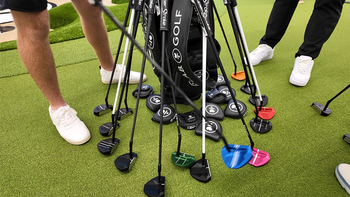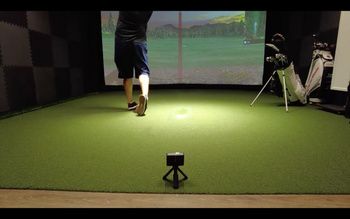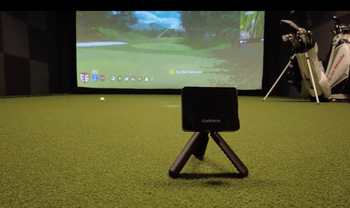Creating a high-quality golf simulator in your own home doesn't have to break the bank. My simulator setup cost around $1,000 and has been a game-changer for my golf game. To start, you'll need a space that's at least 10 ft wide, 15 ft long, and 10 ft high.
Building a golf simulator takes time and effort, but the payoff is well worth it. My simulator has helped me improve my game, and it's also a lot of fun to use. If you're considering building your golf simulator, I recommend going for it. With the right equipment and software, you can create a truly immersive experience that will take your game to the next level.
Experimenting with different settings and features is key to finding the perfect combination for your game. Don't be afraid to try new things and adjust your setup as needed. With patience and practice, you can create a golf simulator that will help you improve your game and provide hours of entertainment.
Remember, building a golf simulator is a process, and it may take some trial and error to get everything just right. But with the right equipment and software, you can create a truly immersive experience that will take your game to the next level. So why not give it a try? With a little patience and practice, you can be enjoying a realistic golfing experience from the comfort of your own home.
Golf Simulator Basic Requirements

Building a golf simulator requires careful consideration of four key elements: space, hitting mat, projector, and screen or net. These components must work in tandem with specialized software to create a realistic and fun golfing experience.
A suitable space is essential, with a minimum width of 10 feet, length of 15 feet, and height of 10 feet to accommodate a comfortable swing. A garage or similar area with enough room to project images is ideal.
While professional golf simulator installations can be pricey, a DIY setup can offer a comparable experience without breaking the bank. With the right setup, you can achieve a great golfing experience that rivals what the pros use.
A reliable projector is crucial to a great golf simulator. Look for one with high lumens, good contrast, and a fast refresh rate. The Epson Home Cinema 1060 is a good option, offering 3,100 lumens and a high contrast ratio.
A durable hitting mat is also necessary, providing a realistic feel and withstanding heavy use. The Cimarron Ultimate Real Feel Hitting Mat is a good choice, featuring a thick, heavy-duty surface and adjustable height settings.
Finally, a durable screen or net is required to catch shots. The Net Return Pro Series is a good option, boasting a sturdy frame and high-quality net that can withstand ball speeds of up to 250 mph.
By carefully selecting these four key elements, you can create a golf simulator that provides a realistic and fun experience, helping you improve your game.
Essential Equipment You'll Need
Creating a golf simulator requires careful consideration of several key components. For a hitting mat, I'm looking for a product that provides realistic feedback, accommodates drivers and fairway woods with tee placement, and is durable enough for long-term use. GoSports, Callaway, and Rukket offer quality options in this category, priced around $60.
Projectors are another crucial element. I need a device that balances affordability with high resolution and compatibility with my computer's inputs. Epson, BenQ, and ViewSonic are top contenders, with prices ranging from $300 to $500.
Some might argue that a screen is essential, but I believe a cost-effective net or tarp can serve as a suitable alternative. My primary concerns are safety and visibility, and I'm confident I can find a solution that meets these needs without breaking the bank.
By focusing on performance and affordability, I aim to create a golf simulator that is both enjoyable and functional. With the right equipment, I can achieve a realistic and immersive experience that enhances my golf game.
Software Options and Features

I'm a firm believer that the right software is key to elevating the golf simulator experience. It provides vital feedback and realistic gameplay. OptiShot software is my go-to choice. It offers fundamental feedback on club head speed, distance, shot shape, and swing path analysis. Customizing weather conditions and play formats is also possible, making it a valuable investment for serious golfers.
Integrating OptiShot into my training routine allows me to track progress and identify areas for improvement. I also consider additional features like swing analysis software, such as V-1 or SwingTIP, to refine my technique. The key is to find software that's both cost-effective and feature-rich.
OptiShot's ability to analyze my swing and provide instant feedback has been a game-changer. Leveraging this technology enables me to fine-tune my skills and gain a competitive edge. My experience with OptiShot has taught me the importance of selecting software that aligns with my training goals. Whether I'm looking to improve my drive or refine my short game, the right software makes all the difference.
Making informed choices and investing in high-quality software is crucial. It unlocks my full potential as a golfer. OptiShot's features, such as customizable weather conditions and play formats, provide a more immersive gaming experience. This takes my golf game to the next level. With the right software, I can enjoy a more realistic and engaging experience.
Creating a Practice Environment
Transforming a garage into an immersive golf practice environment is a game-changer for golfers seeking to refine their techniques. To create this space, key elements are necessary, including a hitting mat, projector, and screen or net. The hitting mat is crucial, as it provides feedback on shots. Ensuring enough space to move around and swing freely is vital.
A good-quality hitting mat is essential, as it helps track progress and identify areas for improvement. With a dedicated practice space, focus on specific skills like driving, putting, or working on the short game is achievable. Practice sessions become more effective, allowing for analysis of swings and adjustments in real-time.
Mimicking course conditions is another crucial aspect. Adjusting lighting and temperature to simulate different times of day and weather conditions helps prepare for various scenarios. Incorporating different terrain and elevation changes to practice shots from various lies also helps develop a more consistent swing.
Regular practice in this setup leads to significant improvements in the game. Shots become more accurate, and a better feel for the club is developed. Muscle memory and consistency are built through repetitive practice, allowing for a more confident game.
By investing in a well-designed practice space, golfers can take their game to the next level and achieve their goals. With the right equipment and setup, the possibilities for improvement are endless.
Enhancing Your Simulator Experience
I've discovered that incorporating practice modes targeting specific skills, like driving or putting, into my golf simulator experience has taken my game to the next level. Instant feedback allows me to track progress and make adjustments. I've started a league with friends, injecting competition and camaraderie into practice sessions.
Investing in instructional content, such as videos and tutorials, has refined my technique and yielded tangible results. Continuously improving my simulator experience not only upgrades my skills but also increases my enjoyment of the game.
The key to engaging practice is mixing things up. Instead of hitting balls into a virtual void, I create scenarios simulating real-world golfing situations. Setting up virtual targets or challenging myself to hit a certain number of balls within a specific distance of the pin adds variety and keeps me focused and motivated.
These small tweaks have made a significant difference. Upgrading my simulator experience has improved my skills and increased my enjoyment of the game. I'm more engaged, motivated, and excited to hit the virtual links every time I step into my simulator.
A basic golf simulator setup can cost around $1,000, while more advanced systems can reach upwards of $5,000. Software is the biggest expense, coming in at around $500. Projectors are the second-largest cost, with budget-friendly options available between $300-$500. Hitting mats and nets are the most affordable, ranging from $40 to $60.
By taking a budget-friendly approach, you can upgrade your setup gradually without overspending. Focus on essential components, such as software and a projector, and then add more features as you can afford them. This approach will help you create a golf simulator that provides a realistic and enjoyable experience without breaking the bank.
Owning a golf simulator can save you money in the long run by reducing the need for frequent trips to the golf course. With a golf simulator, you can practice your swing and improve your game from the comfort of your own home.
Benefits of Year-Round Practice
Golfers who don't practice consistently will struggle to maintain momentum and see their skills deteriorate over time. I strongly advocate for year-round practice with a golf simulator.
A simulator allows me to work on my technique 365 days a year, identifying areas for improvement and tracking my progress. This approach has significantly improved my consistency and confidence on the course.
I've noticed improvements in my swing and short game. When competing against golfers who don't practice as frequently, I feel like I have an advantage. The simulator allows me to schedule practice sessions that fit my busy lifestyle.
Practicing in the comfort of my own home is a huge benefit. I don't have to worry about weather conditions or course availability. I can simply step into my simulator and start practicing. This convenience has been crucial in improving my skills and staying ahead of the competition.
The simulator's ability to track my progress and provide instant feedback has been invaluable. I can analyze my swing and make adjustments in real-time, which has helped me develop muscle memory and improve my overall technique.
Golf simulators are not just for professionals; they're for anyone looking to improve their game. Whether you're a beginner or an experienced golfer, a simulator can help you take your game to the next level. With its convenience, accuracy, and instant feedback, it's an essential tool for any serious golfer.
Customizing Your Setup

Creating a golf simulator setup requires careful planning and research. The first step is to consider the available space. Is it a dedicated room, garage, or basement? This determines the size of the projector and screen needed. The type of hitting mat is also crucial. Does it need a built-in ball return, or will a basic mat suffice?
The projector is a key component. Does it need to simply display the image, or should it have advanced features like ball tracking and swing analysis? The screen or net is also important. Should it be manual or motorized?
Ultimately, the goal is to create a setup that helps improve the game. It can start with a basic setup and upgrade later, or invest in a more advanced system with features like swing analysis software. With careful planning and research, it's possible to create a golf simulator setup that meets specific needs and takes the game to the next level.
A good setup can make a huge difference in the game. It allows for practice in a controlled environment, helping to improve technique and build confidence. The right equipment and software can provide valuable insights and feedback, making it easier to identify areas for improvement.
Investing in a golf simulator setup can be a significant investment, but it's worth it for serious golfers. It provides a convenient and effective way to practice and improve, regardless of the weather or time of day. With the right setup, golfers can take their game to new heights and enjoy the many benefits that come with it.
Conclusion
Creating a DIY golf simulator has saved a considerable amount of money and provided a practice environment tailored to my needs.
National Golf Foundation research indicates that regular practice yields an average improvement of 3-4 strokes per round. By practicing for 30 minutes a day on my simulator, I'm confident I can achieve these gains and start shaving strokes off my game.
Professional golfers such as Rory McIlroy and Tiger Woods use simulators for good reason. Practice plays a significant role in golf. By dedicating time each day to practice, I'm able to improve technique and build muscle memory.
One of the benefits of the simulator is that it's customizable. I can set it up to work on various aspects of my game, such as my short game, putting, or driving.





